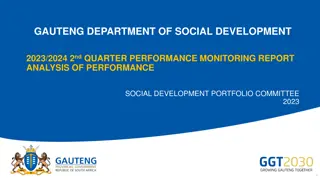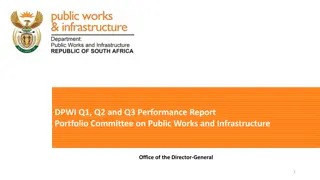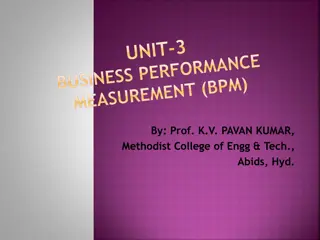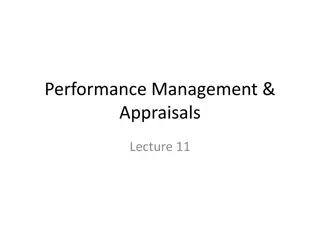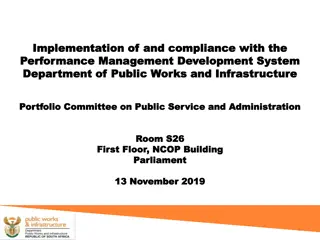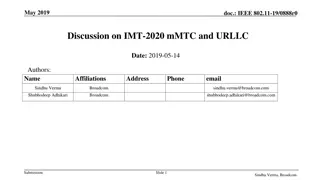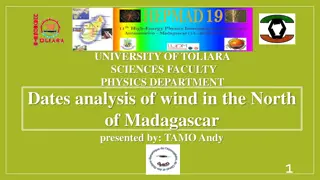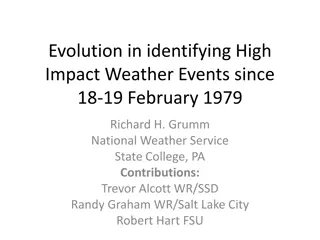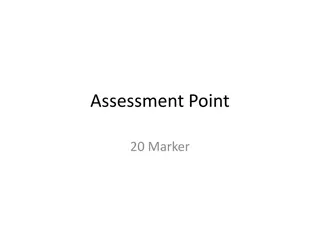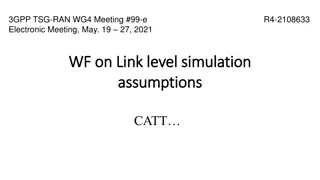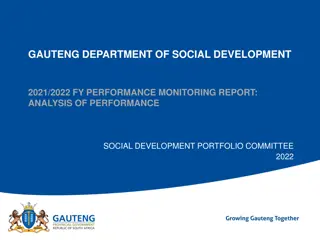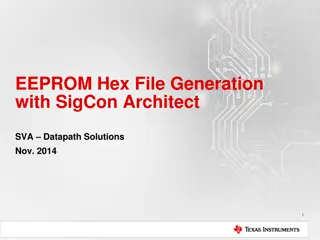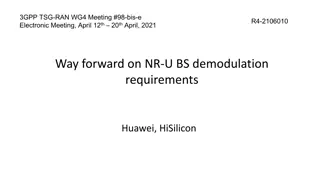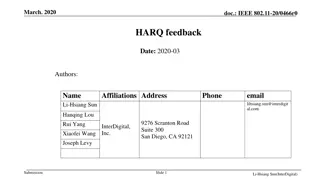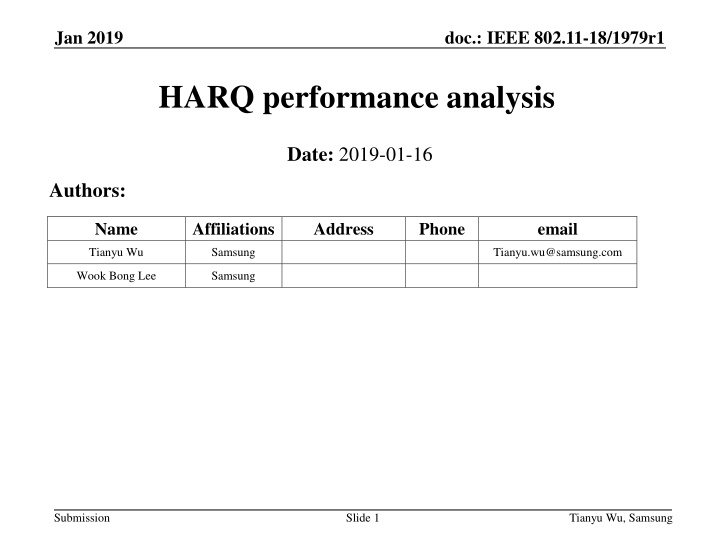
IEEE 802.11 HARQ Performance Analysis and Comparison
"Explore the performance analysis of Hybrid Automatic Repeat reQuest (HARQ) in IEEE 802.11 standards, discussing aspects like link adaptation, throughput, and error rates. Understand the impact of HARQ mechanisms on wireless communication systems and how they compare with traditional transmission methods." (297 characters)
Uploaded on | 1 Views
Download Presentation

Please find below an Image/Link to download the presentation.
The content on the website is provided AS IS for your information and personal use only. It may not be sold, licensed, or shared on other websites without obtaining consent from the author. If you encounter any issues during the download, it is possible that the publisher has removed the file from their server.
You are allowed to download the files provided on this website for personal or commercial use, subject to the condition that they are used lawfully. All files are the property of their respective owners.
The content on the website is provided AS IS for your information and personal use only. It may not be sold, licensed, or shared on other websites without obtaining consent from the author.
E N D
Presentation Transcript
Jan 2019 doc.: IEEE 802.11-18/1979r1 HARQ performance analysis Date: 2019-01-16 Authors: Name Affiliations Address Phone email Tianyu Wu Samsung Tianyu.wu@samsung.com Wook Bong Lee Samsung Submission Slide 1 Tianyu Wu, Samsung
Nov 2018 doc.: IEEE 802.11-18/1979r1 Abstract There are a number of EHT contributions discussing HARQ [1,2,3,4,5]. In this contribution, we share some simulation results and our thoughts on this feature. Submission Slide 2 Tianyu Wu, Samsung
Jan 2019 doc.: IEEE 802.11-18/1979r1 HARQ and Link adaptation HARQ is an add-on feature for open loop link adaptation schemes. AMPDU 1 AMPDU 2 LA: MPDU 1 MPDU 2 MPDU 3 MPDU 4 BA MPDU 2 MPDU 5 MPDU 6 BA Failed MPDU Retransmitted MPDU 2, MCS selection follow LA algorithm. AMPDU 1 AMPDU 2 LA+ HARQ: MPDU 1 MPDU 2 MPDU 3 MPDU 4 BA MPDU 2 MPDU 5 MPDU 6 BA Failed MPDU Retransmitted MPDU 2. Chase combining: repeated MPDU 2 with same MCS. IR: More redundant parts of MPDU 2. RX side need to store the failed MPDU 2 for combining. HARQ major complexity and cost Extra memory for the failed MPDUs Hard to estimate how many extra memory at AP side to support HARQ for a large number of STAs. Hard to predict when the retransmission arrives and how long need to store the failed MPDUs. Implementation complexity Large change/complexity in implementation to support this feature. Extra overhead in PHY header to indicate the Rx identity, new MAC protocols as well as sophisticated PHY designs. For Incremental redundancy (IR), also need to modify existing coding chain and bring more complexity. Submission Slide 3 Tianyu Wu, Samsung
Jan 2019 doc.: IEEE 802.11-18/1979r1 Performance comparison To evaluate HARQ, we compare the PER performance and Throughput performance for schemes w/wo HARQ PER comparison Compare the PER curves for different MCSs w/wo HARQ CC or HARQ CC+div. HARQ CC: Retransmission same MPDU when there is a fail. HARQ CC+div: HARQ CC with retransmission diversity. In retransmitted MPDU, a different BCC interleaver/LDPC tone mapper is applied for extra diversity gain. Throughput comparison Compare the throughput of link adaptation (LA) algorithms w/wo HARQ Baseline LA algorithms includes: AARF[6]: Adaptive auto rate fallback. Decrease the MCS after two consecutive fails. Try higher MCS level after an adaptive threshold number of success transmissions. When a probe packet fails, switch back to previous lower rate and also multiply by 2 the threshold required to switch to a higher rate (Max 50). Some enhanced LA algorithm. Submission Slide 4 Tianyu Wu, Samsung
Jan 2019 doc.: IEEE 802.11-18/1979r1 PER performance HARQ CC has 3dB PER gain. HARQ CC+div has ~7dB PER gain for high MCSs. Careful selection of interleaver/ tone mapper for the retransmitted packet may bring a few dB more PER gain. For low MCSs less gain due to preamble errors. The preamble becomes the bottleneck. PER is an indirect metric for performance comparison. PER is not a fair comparison: For each MCS, the PER gain is comparing HARQ (combination of 2 transmissions) with single transmission. Large PER gain may not lead to significant throughput gain, especially comparing with good link adaptation algorithms. Example: MCS8 w HARQ CC+div has ~7dB SNR gain to MCS8 and over perform retransmission with MCS8. However, MCS8 w HARQ only has same thp as MCS4. Link adaptation using MCS7 could be better choice. Submission Slide 5 Tianyu Wu, Samsung
Jan 2019 doc.: IEEE 802.11-18/1979r1 Throughput performance comparison Not much thp gain comparing to LA wo HARQ With 10% target PER, the throughput gain is very small. With 30% target PER, there is thp loss in high SNR case. Reason: retransmission loss is large with high MCS. Example: Retransmission of MCS8 has thp of MCS4. 30% chance reduce MCS8 to MCS4 is not a good choice. HARQ CC+div has little gain over HARQ CC Extra PER gain not converted to throughput gain. Reason: Same resource used for 2 HARQ schemes. In most cases, the packet will get through with HARQ retransmission, for either CC or CC+div scheme. With more MCS levels, the thp will increase. SNR gaps for current MCSs are large. Define more MCSs in the middle will help improve the thp. But it helps both w/wo HARQ cases similarly. Low SNR case has larger thp gain in percentage. Absolute value of thp gain is still small. In MCS0 case, preamble may become bottle neck. After considering preamble error, the thp gain will be smaller. Submission Slide 6 Tianyu Wu, Samsung
Jan 2019 doc.: IEEE 802.11-18/1979r1 More thoughts Proper link adaptation algorithm will follow the effective SINR of the time varying channel. Example: 26dB SNR at channel D. From Fig 3, seem that without HARQ, Tx should select MCS7. However, this is only true without link adaptation. For 26dB SNR, the time domain effective SINR is shown in Fig 2. With link adaptation, if effective SINR is below the gold line in Fig 2, transmitter can use MCS7. If it is above that line, transmitter can use MCS8. In slow varying Wi-Fi channels, the link adaptation algorithm works well. Fig.1 Fig.3 Fig.2 26dB Submission Slide 7 Tianyu Wu, Samsung
Jan 2019 doc.: IEEE 802.11-18/1979r1 Throughput on bursty interfered channel There could be bursty interferences and affect the link SINR. Example: even RTS/CTS is applied, there could still be interferences <-82dBm. For fast fading /bursty interference case, throughput for both LA and HARQ cases decrease. With carefully selected target PER for the 1st packet, HARQ has more gain. For small SNR and large SNR range, there are almost no throughput gain. Optimal target PER for HARQ is not fixed, very hard to dynamically adapt. With bursty interference, 30% target PER achieve larger throughput gain With no bursty interference, 30% target PER suffer from throughput loss. -85dBm interference -90dBm Submission Slide 8 Tianyu Wu, Samsung
Jan 2019 doc.: IEEE 802.11-18/1979r1 Performance of HARQ IR HARQ IR has two types Additional redundant information bits. This scheme is similar to introducing more MCS levels in the middle of existing MCSs. We evaluated this HARQ scheme. Self decodable retransmission. More complex to design the code. We compare the throughput performance HARQ IR with LA wo HARQ and other HARQ modes. HARQ IR can achieve ~1.5dB throughput gain. Larger than HARQ CC case. Additional overhead not considered. HARQ IR can sent additional redundant packet which can be much smaller than retransmission the whole original packet in LA wo HARQ case and HARQ CC case. Submission Slide 9 Tianyu Wu, Samsung
Jan 2019 doc.: IEEE 802.11-18/1979r1 Summary on HARQ Performance of different HARQ modes are evaluated. PER performance and throughput performance are compared. PER performance HARQ CC with simple retransmission will bring ~3dB gain. Retransmission diversity can bring extra diversity gain especially for high MCS. However, PER gain will convert to little throughput gain. Throughput performance HARQ CC brings very little throughput gain comparing to good link adaptation algorithms. Retransmission diversity not helping much. HARQ IR can achieve larger throughput gain with cost of extra complexity. Need to consider whether introducing HARQ is a good tradeoff of cost/complexity and performance gain. Prefer not require non-AP STA to support this feature. Submission Slide 10 Tianyu Wu, Samsung
Jan 2019 doc.: IEEE 802.11-18/1979r1 Reference [1] 11-18/1116 Multi AP and HARQ for EHT [2] 11-18/1587 HARQ for EHT [3] 11-18/1547 Technology Features for 802.11 EHT [4] 11-18/1549 Candidate Technology Review [5] 11-18/1171 View on EHT objectives and technologies [6] IEEE 802.11 Rate Adaptation: A practical Approach. M. Lacage etc. Submission Slide 11 Tianyu Wu, Samsung

